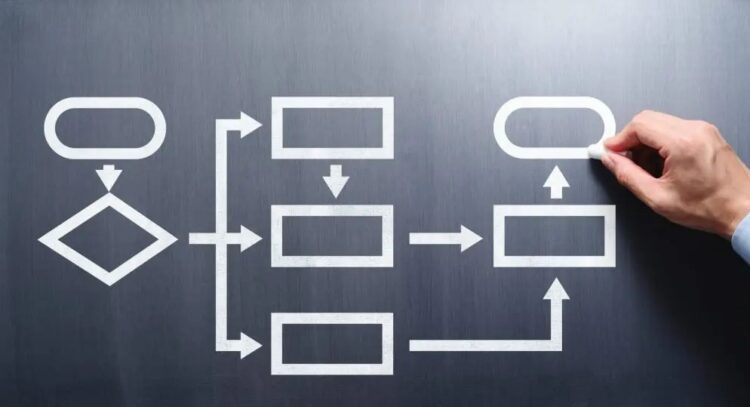Running a business requires attention to ways to improve efficiency in the office. Whatever time you waste doing things that will not bring in profit will come back to affect the amount of profit you are making. For this reason, you need to find a way to ensure that everything is running according to plan. Many companies are employing the use of flowcharts in the office. Here are the main reasons why they do it and why you should consider using flow charts.
1. It defines a work process
Sometimes when embarking on a new project, no one has an idea of what should happen and at what time. It can lead to confusion and a lot of back and forth before work officially resumes. Ensuring everything is going according to plan helps get a flowchart creator at miro.com and develop a way to detail the entire work process. Anyone who gets lost along the way can refer to the flowchart and figure out their bearing from there. It ensures that no one person is left behind and work will move according to schedule. The employees get to understand the amount of workload to allow for planning by understanding the data conditions that will produce desired business outcomes
2. It helps train new employees

Whenever you get new employees in your business, you need to train them on what to expect. While most organizations prefer taking the new employees around, this takes so much time, which means more people will be distracted by all the movement. The best way to integrate these employees would be to detail the business in a flowchart. You can then give a short presentation, ask questions, and get everyone to work. It will save you a lot of time and ensure that you get everyone on board simultaneously. The trick for flowcharts is to understand that following a single path with data decision and an outoe represents one option of the production process. The different paths offer alternatives from which the best path will suffice as a good business process to follow.
3. It helps monitor productivity and efficiency
One of the things many offices do without even knowing is waste time. Certain steps are so unnecessary that you might be making losses every time you work on something new. The solution to this is to design a flowchart of your work process. In doing this, you can look at the bigger picture and figure out anything you can do differently. You can also decide if you need to cut out some steps and speed up the work process. If you have a detailed flowchart, all these will be clear to you. You might need to go over it a couple of times, but it will be worth it in the end. It will save time and money and boost productivity in the entire organization.
4. Offers visual clarity

The diagrammatic nature makes it an ideal tool for different problem-solving ventures at the workplace when seeking desirable business outcomes. The use of arrows shows each step’s outcomes and makes it follow through with the plan to solve a problem. The use of decision boxes and the resulting outcomes gives the impression of the best steps to achieve company goals. The high level of visual clarity and direction make it a good communication tool when reviewing company processes to determine areas of weakness. Therefore, the flowchart offers a tool for creating improvements to the initial business processes for better results in the future.
5. Tool for documentation
Flowcharts are a tool for documenting business activities because they highlight the steps for accomplishing specific business procedures. The documentation involving flowcharts offers an opportunity where reviews are possible to determine the effectiveness of particular business strategies. The benefit of such available documentation is that it offers a chance to check the different outcomes and determine different tweaks in the process that gives better results. Documentation using flowcharts also offers accountability by outlining the data on finances and revenues, the decisions of the process and their impact on the productivity of the business.
6. Ease of coordination between departments

The working environment brings together departments that accomplish small tasks that contribute to the bigger company goals. However, constant data and information exchange between departments have a common objective of increasing efficiency. The use of flowcharts to record data analysis procedures and production steps means that such data can be useful in different departments where interpretation is easy. Therefore, flowcharts improve the relationship between departments in your company by ensuring prompt and effective data exchange.
7. Data analysis tool
Flowcharts are useful data analysis tools when writing a project where different data sets need evaluation to establish their possible impacts on a procedure. Using flowcharts to analyze data ensures that a decision-making opportunity arises from the potential outcomes of using different data combinations. The presentation of the charts means that decision-making is simple because each data combination provides a predictable outcome. The outcomes require zero analysis to know which one is desirable as long as data analysis is over.
8. Ease of creating a flowchart

A flowchart needs minimum energy to draw because of its distinct decisions that create specific outcomes. Create links between various data, processes, decisions, and consequent outcomes. The arrows are such that data analysis leads to decisions where every choice on the decision box leads to a unique outcome representing the consequence of production steps. Additionally, computer software exists today to help make creating flowcharts easy. The software provides different templates to enter the data, decision questions, and outcome statements. The computer then creates the flowchart impression of your choice.
Running a business demands you to be on top of everything you do. Lack of keenness creates mistakes in your company. Using a flowchart that offers detail about the process, type of data in use, decision-making, and outcomes relieve the management. Quickly making the right decisions means that the business is run efficiently with your resources. With a well-designed and executable flowchart, you get to know what is happening at what time. It will go a long way to ensure that you are running a tight ship, which will bring in the most returns at the end of the day.
 Hi Boox Popular Magazine 2024
Hi Boox Popular Magazine 2024



